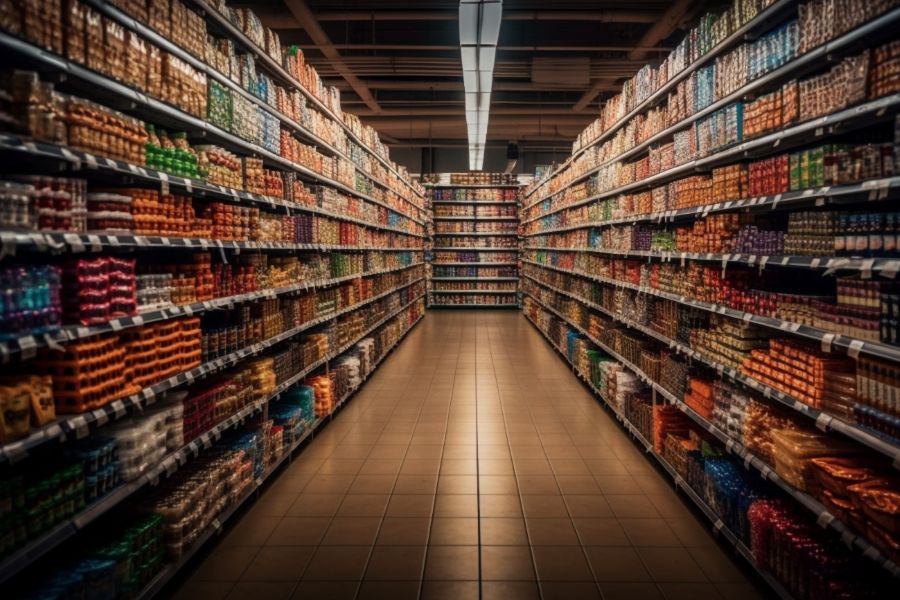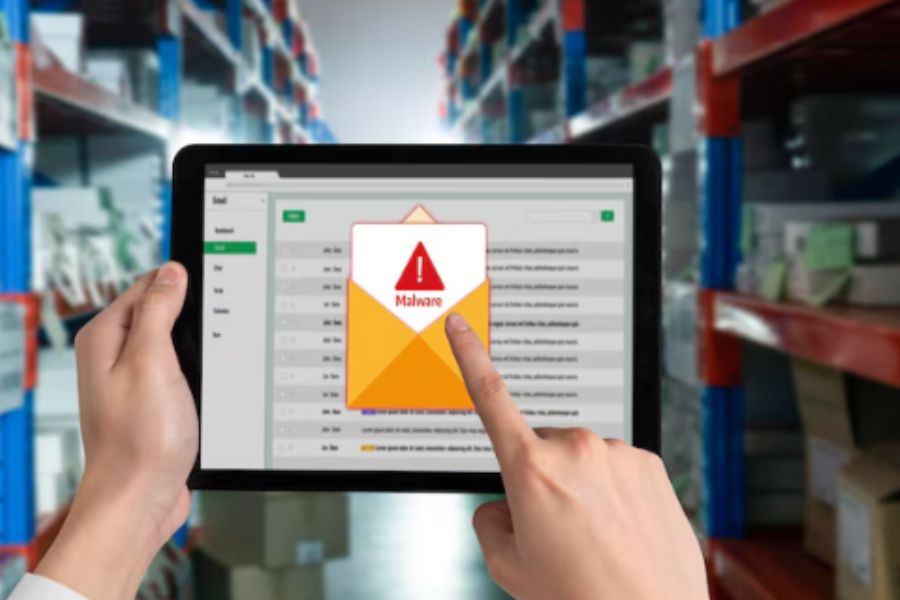As traditional retail models evolve to meet the demands of today’s tech-savvy and diverse consumer base, embracing endless aisles solutions offers retailers unprecedented opportunities to enhance customer experiences and drive growth. This article explores the significance of adopting such solutions, delving into their potential to revolutionize the retail sector by blurring the boundaries between physical and digital shopping realms.
What Are Endless Aisles?
According to Statista, 37% of in-store shoppers will shop elsewhere if the item they want is out of stock. Furthermore, nearly half would simply walk out and forsake the purchase entirely. This is where businesses must capitalize on a nearly-lost transaction by forecasting demand and extending inventory with an ‘endless aisle’ solution.
Endless aisles refer to a modern retail concept that transcends the limitations of physical store space through digital innovation. In essence, it involves offering customers an extensive array of products beyond what can be physically displayed within a brick-and-mortar store. Through online platforms, retailers can provide shoppers with access to a virtually unlimited catalog of items, creating a seamless connection between in-store and online shopping experiences.
This approach leverages technology to create a digital storefront where customers can explore and purchase a wide variety of products that might not be feasible to stock within a physical location due to space constraints or other factors. By integrating elements like interactive kiosks or online browsing stations within the store, retailers can blend the tactile in-person shopping environment with the virtually limitless options available online.
Endless aisles are closely tied to the concept of omnichannel retailing, which emphasizes a cohesive shopping experience across various channels. This strategy not only broadens the range of products accessible to customers but also allows for personalized recommendations based on individual preferences and shopping behaviors.
Advantages Of Implementing Endless Aisles:
Implementing endless aisles within a point-of-sale (POS) system offers a range of compelling advantages that can significantly elevate a retailer’s operational efficiency and customer relationships:
Lower Inventory Holding
The integration of endless aisles allows retailers to minimize the need for extensive physical inventory. By digitally showcasing an expanded product range and employing drop shipping methods, retailers can offer a diverse selection without the burden of storing excess stock. This results in reduced inventory costs, freeing up valuable space, and enabling better allocation of resources for other aspects of the business.
Decreased Online Return Rates
Endless aisles contribute to a reduction in online return rates by providing customers with comprehensive product details and reviews. Shoppers can make more informed decisions, selecting items that better match their needs and preferences. This leads to higher satisfaction levels and fewer instances of product returns, ultimately saving retailers time, money, and effort associated with handling returns.
Enhanced Customer Loyalty
By granting customers access to a vast array of products through endless aisles, retailers can cultivate stronger customer loyalty. The convenience of finding niche or specialty items within the digital catalog enhances the overall shopping experience. Satisfied customers are more likely to return for future purchases and develop a deeper bond with the brand, fostering loyalty and advocacy.
This forward-looking approach caters to modern shopping preferences, positioning retailers to excel in an increasingly digital and competitive marketplace.
The Challenge Of Endless Aisles
While the concept of endless aisles in retail brings numerous benefits, it also presents several challenges that retailers need to address for successful implementation. Some of these challenges include:
- Technological Infrastructure: Setting up and maintaining the required technology infrastructure to seamlessly integrate the digital catalog, POS system, and online platform can be complex and expensive. Retailers need robust systems capable of handling a high volume of online traffic, secure transactions, and real-time inventory updates.
- Data Accuracy: Ensuring accurate and up-to-date product information across the digital catalog and physical store is crucial. Discrepancies between online and in-store stock levels, prices, or product details can lead to confusion, customer frustration, and lost sales.
- Inventory Management: Coordinating inventory between physical stores, warehouses, and potential third-party suppliers for drop shipping requires effective inventory management systems. Overestimating demand or encountering supply chain issues can lead to stockouts or delays in fulfilling orders.
- Product Quality Control: When relying on third-party suppliers for drop shipping, maintaining consistent product quality can be a challenge. Ensuring that customers receive the same level of quality they expect from the brand’s physical store is essential for building trust.
- Customer Experience: While endless aisles offer convenience, some customers may prefer the tactile experience of physically examining products before purchase. Balancing the digital and in-store experiences to cater to diverse customer preferences can be tricky.
- Returns and Exchanges: Handling returns and exchanges for products ordered through endless aisles can be complex. Customers may need to return items to physical stores, leading to potential confusion and additional logistical challenges.
- Fulfillment Efficiency: Coordinating and optimizing the fulfillment process for orders placed through endless aisles, especially those involving drop shipping, requires careful planning to ensure timely deliveries and minimize shipping costs.
- Integration with POS: Seamlessly integrating the endless aisles concept with the point-of-sale system is essential. This integration ensures that inventory levels are accurately updated across all channels, and customers have a consistent experience whether they shop online or in-store.
- Data Privacy and Security: Handling customer data and payment information online introduces cybersecurity concerns. Retailers must prioritize data security to protect customer information and maintain their trust.
Overall, retailers that successfully navigate these challenges can reap the rewards of increased customer satisfaction, expanded product offerings, and a competitive edge in the evolving retail landscape.
Variations Of Endless Aisle Strategies
There are several variations of the endless aisle strategy that retailers can employ to enhance the shopping experience and expand their product offerings. Here’s an overview of the variations you’ve mentioned:
- Interactive Kiosks: Interactive kiosks are physical stations placed within a retail store that allows customers to browse and order products not available on the shelves. Customers can use the kiosk to access a digital catalog, view product details, and place orders. These kiosks bridge the gap between the physical and digital shopping experiences, offering customers a broader selection of products while still being present in the store environment.
- Showrooming: Showrooming involves customers visiting a physical store to view products in person and then making their purchases online. In this strategy, the store serves as a showroom where customers can experience products firsthand, and then they may choose to order the product through the retailer’s online platform. Showrooming leverages the in-store experience to drive online sales.
- Order Fulfillment: In this approach, retailers allow customers to place orders for products that are not available in the store, and then have those items shipped directly to the customer’s desired location. This strategy is often associated with drop shipping, where the retailer partners with suppliers or manufacturers who handle the shipping process. It minimizes the need for retailers to hold extensive inventory.
- Consumer PWA App: A Progressive Web App (PWA) is a type of mobile application that is delivered through a web browser. Retailers can offer their customers a PWA app that provides access to a digital catalog of products. Customers can browse, search, and purchase products through the app, whether they’re in-store or on the go. PWAs offer a seamless experience across devices without the need to download and install a traditional app.
Each of these variations offers a unique way for retailers to implement the endless aisle strategy. By leveraging interactive technology, enhancing the showroom experience, optimizing order fulfillment, or providing a dedicated app, retailers can cater to diverse customer preferences, increase their product offerings, and create a more personalized and convenient shopping journey.
Enhancing Inventory Possibilities By Endless Aisle Solutions
Enhancing inventory possibilities through endless aisle solutions offers retailers a range of strategic advantages that can revolutionize their operations and customer experiences. Here’s a breakdown of these benefits:
- User-Friendliness: Endless aisle solutions prioritizes a user-friendly interface that empowers both customers and staff. Intuitive navigation and clear product presentation facilitate effortless browsing, ensuring that customers can easily explore the extended product range. For store personnel, a user-friendly system streamlines order placement, minimizing training requirements and enhancing efficiency.
- Seamless Integration Capabilities: Implementing endless aisle solutions involves integrating digital catalogs with existing inventory systems, e-commerce platforms, and point-of-sale terminals. This seamless integration allows real-time inventory updates across all channels. As customers place orders, stock levels are automatically adjusted, reducing the risk of overselling and improving inventory accuracy.
- Tailoring and Adaptability: Endless aisle solutions can be tailored to match a retailer’s unique branding and product offerings. This adaptability extends to the selection of items showcased digitally, allowing retailers to curate their digital catalog to align with customer preferences, seasonal trends, or marketing campaigns. Such customization fosters a personalized shopping experience that resonates with individual shoppers.
- Instantaneous Data Processing: With endless aisle solutions, data processing occurs in real-time. As customers interact with the digital catalog, search for products, and place orders, the system instantly updates information such as available stock, pricing, and product details. This ensures that customers always receive accurate and up-to-date information, fostering trust and reducing the potential for confusion.
Incorporating these enhancements into inventory management through endless aisle solutions optimizes retail operations and transforms the customer journey. The synergy between user-friendliness, integration capabilities, adaptability, and real-time data processing ensures a seamless experience for both customers and retailers, facilitating informed purchasing decisions, streamlined operations, and a strengthened brand-customer relationship.
Endless Aisle Examples In Expanding Inventory Possibilities
There are a few examples of how the endless aisle concept has been implemented in various industries:
- Retail Stores: In a traditional retail store, interactive kiosks can be strategically placed throughout the aisles. Customers can use these kiosks to access the store’s online catalog, view additional product options, check availability, and even place orders for items that are not physically present in the store. This extends the store’s inventory virtually, offering customers a wider selection without needing to stock every item on-site.
- Home Improvement Stores: Home improvement retailers can implement endless aisle solutions to cater to customers’ varied project needs. For instance, customers looking for specific types of tiles, paints, or fixtures can use in-store kiosks to explore different options and place orders for delivery or pickup, even if the items are not in stock at that location.
- Electronics Stores: Electronics retailers can showcase a wide range of products through interactive displays. Customers can use touch screens to learn about features, compare specifications, and make informed decisions. If a particular model or configuration is not in stock, customers can place orders for home delivery, ensuring they get exactly what they want.
- Apparel Stores: In clothing stores, customers can use touchscreens or dedicated apps to view an extended range of sizes, colors, and styles that might not be available in the physical store. They can place orders for items that fit their preferences and have them shipped to their home or the store for pickup.
- Grocery Stores: Even in the grocery industry, endless aisle solutions can be applied. Shoppers can use digital screens or apps to access an online inventory of items, including specialty or out-of-season products. They can then order these items for home delivery, ensuring they can access their preferred groceries without needing to visit multiple stores.
- Automotive Parts Stores: Endless aisle solutions can be particularly helpful in automotive parts stores where customers often need specific components for their vehicles. Customers can input their vehicle details into an interactive system, which then presents them with compatible parts and accessories, even if they’re not available in-store.
These examples highlight the versatility of the endless aisle concept across various industries. By incorporating technology and online capabilities into the traditional retail environment, businesses can enhance the customer experience, increase sales opportunities, and cater to a broader range of customer needs.
Conclusion
In a world where consumer expectations are continually evolving, integrating endless aisle solutions stands as a strategic imperative for retailers aiming to remain competitive and customer-centric. The convergence of in-store experiences with the virtually limitless array of products attainable through these solutions not only addresses inventory constraints but also empowers shoppers with unprecedented choice and convenience. For more information about endless aisles, don’t hesitate to get in touch with us.



